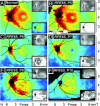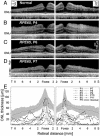Identifying photoreceptors in blind eyes caused by RPE65 mutations: Prerequisite for human gene therapy success
- PMID: 15837919
- PMCID: PMC1087926
- DOI: 10.1073/pnas.0500646102
Identifying photoreceptors in blind eyes caused by RPE65 mutations: Prerequisite for human gene therapy success
Abstract
Mutations in RPE65, a gene essential to normal operation of the visual (retinoid) cycle, cause the childhood blindness known as Leber congenital amaurosis (LCA). Retinal gene therapy restores vision to blind canine and murine models of LCA. Gene therapy in blind humans with LCA from RPE65 mutations may also have potential for success but only if the retinal photoreceptor layer is intact, as in the early-disease stage-treated animals. Here, we use high-resolution in vivo microscopy to quantify photoreceptor layer thickness in the human disease to define the relationship of retinal structure to vision and determine the potential for gene therapy success. The normally cone photoreceptor-rich central retina and rod-rich regions were studied. Despite severely reduced cone vision, many RPE65-mutant retinas had near-normal central microstructure. Absent rod vision was associated with a detectable but thinned photoreceptor layer. We asked whether abnormally thinned RPE65-mutant retina with photoreceptor loss would respond to treatment. Gene therapy in Rpe65(-/-) mice at advanced-disease stages, a more faithful mimic of the humans we studied, showed success but only in animals with better-preserved photoreceptor structure. The results indicate that identifying and then targeting retinal locations with retained photoreceptors will be a prerequisite for successful gene therapy in humans with RPE65 mutations and in other retinal degenerative disorders now moving from proof-of-concept studies toward clinical trials.
Figures




Similar articles
-
Canine and human visual cortex intact and responsive despite early retinal blindness from RPE65 mutation.PLoS Med. 2007 Jun;4(6):e230. doi: 10.1371/journal.pmed.0040230. PLoS Med. 2007. PMID: 17594175 Free PMC article.
-
Long-term restoration of rod and cone vision by single dose rAAV-mediated gene transfer to the retina in a canine model of childhood blindness.Mol Ther. 2005 Dec;12(6):1072-82. doi: 10.1016/j.ymthe.2005.08.008. Epub 2005 Oct 14. Mol Ther. 2005. PMID: 16226919 Free PMC article.
-
Lentiviral gene transfer of RPE65 rescues survival and function of cones in a mouse model of Leber congenital amaurosis.PLoS Med. 2006 Oct;3(10):e347. doi: 10.1371/journal.pmed.0030347. PLoS Med. 2006. PMID: 17032058 Free PMC article.
-
RPE65: role in the visual cycle, human retinal disease, and gene therapy.Ophthalmic Genet. 2009 Jun;30(2):57-62. doi: 10.1080/13816810802626399. Ophthalmic Genet. 2009. PMID: 19373675 Free PMC article. Review.
-
Leber congenital amaurosis due to RPE65 mutations and its treatment with gene therapy.Prog Retin Eye Res. 2010 Sep;29(5):398-427. doi: 10.1016/j.preteyeres.2010.04.002. Epub 2010 Apr 24. Prog Retin Eye Res. 2010. PMID: 20399883 Free PMC article. Review.
Cited by
-
Synergistically acting agonists and antagonists of G protein-coupled receptors prevent photoreceptor cell degeneration.Sci Signal. 2016 Jul 26;9(438):ra74. doi: 10.1126/scisignal.aag0245. Sci Signal. 2016. PMID: 27460988 Free PMC article.
-
Residual Foveal Cone Structure in CNGB3-Associated Achromatopsia.Invest Ophthalmol Vis Sci. 2016 Aug 1;57(10):3984-95. doi: 10.1167/iovs.16-19313. Invest Ophthalmol Vis Sci. 2016. PMID: 27479814 Free PMC article.
-
A comprehensive review of retinal gene therapy.Mol Ther. 2013 Mar;21(3):509-19. doi: 10.1038/mt.2012.280. Epub 2013 Jan 29. Mol Ther. 2013. PMID: 23358189 Free PMC article. Review.
-
Leber congenital amaurosis caused by mutations in GUCY2D.Cold Spring Harb Perspect Med. 2014 Sep 25;5(1):a017350. doi: 10.1101/cshperspect.a017350. Cold Spring Harb Perspect Med. 2014. PMID: 25256176 Free PMC article. Review.
-
A novel mutation in the RPE65 gene causing Leber congenital amaurosis and its transcriptional expression in vitro.PLoS One. 2014 Nov 10;9(11):e112400. doi: 10.1371/journal.pone.0112400. eCollection 2014. PLoS One. 2014. PMID: 25383945 Free PMC article.
References
-
- Thompson, D. A. & Gal, A. (2003) Prog. Retin. Eye Res. 22, 683-703. - PubMed
-
- Marlhens, F., Bareil, C., Griffoin, J. M., Zrenner, E., Amalric, P., Eliaou, C., Liu, S. Y., Harris, E., Redmond, T. M., Arnaud, B., et al. (1997) Nat. Genet. 17, 139-141. - PubMed
-
- Gu, S. M., Thompson, D. A., Srikumari, C. R., Lorenz, B., Finckh, U., Nicoletti, A., Murthy, K. R., Rathmann, M., Kumaramanickavel, G., Denton, M. J., et al. (1997) Nat. Genet. 17, 194-197. - PubMed
-
- Redmond, T. M., Yu, S., Lee, E., Bok, D., Hamasaki, D., Chen, N., Goletz, P., Ma, J. X., Crouch, R. K. & Pfeifer, K. (1998) Nat. Genet. 20, 344-351. - PubMed
Publication types
MeSH terms
Substances
Grants and funding
LinkOut - more resources
Full Text Sources
Other Literature Sources
Medical
Molecular Biology Databases
Research Materials

